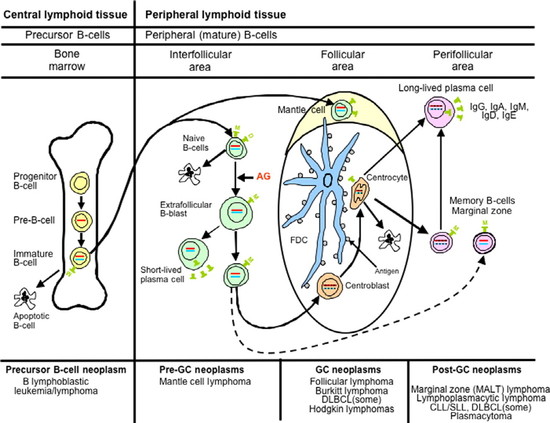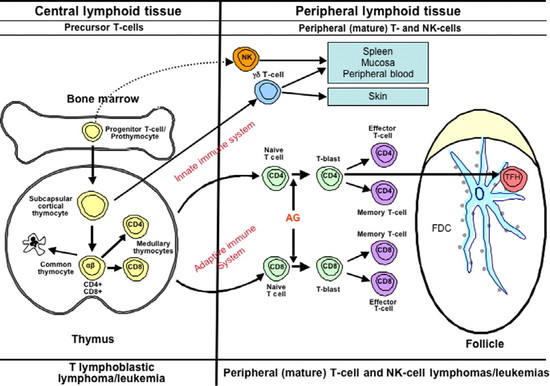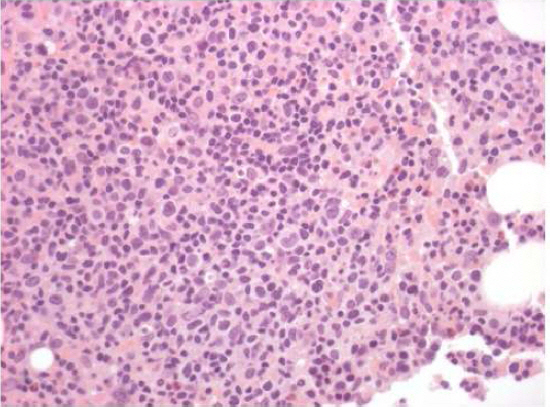
[그림 1. 림프종 진단과 분류의 역사]
외투막세포 림프종(Mantle cell lymphoma , MCL)은 Kiel 분류법과 변형 Rappaport 분류에서 각각 centrocytic lymphoma, lymphocytic lymphoma of intermediate differentiation (IDL)로 기술하였다. 당시에는 형태학적으로 비슷한 림프종을 정확하게 구별할만한 기준이 없었다. 그러나 MCL의 특징적인 면역표현형이 CD5+, CD23?, CD10?, monoclonal B cell이라는 사실이 알려지면서 훨씬 명확하게 정의할 수 있게 되었다.
그리고 MCL의 유전학적 연구로 t(11;14), CCNDI/IGH 유전자 전위가 밝혀지면서 면역조직화학검사에cyclin D1이 도입되었다. 그리고 고등급 변이형(high-grade variants)에서는 p53와 p16 결실/돌연변이 같은 이차적인 유전자 변화가 나타난다는 사실이 발견되어 "blastoid subtype"이라는 조직학적 아형 분류도 가능해졌다. 따라서 오늘날 림프종 분류는 이러한 면역표현형과 유전학적 변화를 종합하여 만들어진 것이다.
<약어설명>
PDL, poorly differentiated lymphocytic; WDL, well-differentiated lymphocytic;
DHL, diffuse histiocytic lymphoma; and MZL, marginal zone lymphoma.

[그림 2. B-세포 분화와 주요한 B-세포 림프종과의 관련성]
B-cell neoplasms correspond to stages of B-cell maturation, even though the precise cell counterparts are not known in all instances. Precursor B cells that mature in the bone marrow may undergo apoptosis or develop into mature naive B cells that, following exposure to antigen and blast transformation, may develop into short-lived plasma cells or enter the germinal center (GC), where somatic hypermutation and heavy chain class-switching occur. Centroblasts, the transformed cells of the GC, either undergo apoptosis or develop into centrocytes. Post-GC cells include both long-lived plasma cells and memory/marginal zone B cells. Most B cells are activated within the GC, but T cell?independent activation can take place outside of the GC and also probably leads to memory-type B cells.
<약어/부호 설명>
GC, germinal center; AG, antigen; FDC, folllicular dendritic cell.
Red bar, immunoglobulin heavy chain gene (IGH@) rearrangement;
blue bar, immunoglobulin light chain gene (IGL) rearrangement;
black insertions in the red and blue bars, somatic hypermutation.

[그림 3. T-세포 분화와 기능]
Lymphoid progenitors enter the thymus where precursor T cells develop into varied types of naive T cells. The cells of the innate immune system include NK cells, T cells, and NK-like T cells. These cells constitute a primitive type of immune response that lacks both specificity and memory. In the adaptive immune system, T cells leave the thymus, where, upon exposure to antigen, they may undergo blast transformation and develop further into CD4 and CD8 effector and memory T cells. T cells of the adaptive immune system are heterogeneous and functionally complex, and include naive, effector (regulatory and cytotoxic), and memory T cells. Another specific type of effector T cells is the follicular helper T-cell that is found in GCs (TFH). Upon antigenic stimulation, T-cell responses may occur independent of the GC, or in the context of a GC reaction. The lymphomas of the innate immune system are predominantly extranodal in presentation, mirroring the distribution of the functional components of this system.113 T-cell lymphomas of the adaptive immune system present primarily in adults, and are mainly nodal in origin.

림프종은 B-림프구, T-림프구, 자연살해세포(natural killer, NK세포), 리드스텐버그(Reed-Sternberg)세포 또는 림프구와 조직구(팝콘세포)에서 기원하는 림프세포증식질환으로 단일질환이 아니고 이질성 질환의 집합체이다. 비호지킨 림프종은 우리나라 전체 악성림프종의 95.6%를 차지하며 호지킨림프종은 4.4%를 차지한다. 비호지킨 림프종 중 미만성 큰 B-세포 림프종(DLBCL)이 41.3%, 결절외변연부세포 림프종이 18.4%, 결절외NK/T-세포 림프종이 6.1%, 주변T-세포 림프종이 5.8%로 흔하다.
◎ Precursor lymphoid Neoplsms 전구세포종양
B lymphoblastic leukemia/lymphoma, NOS
B lymphoblastic leukemia/lymphoma with recurrent genetic abnormalities
B lymphoblastic leukemia/lymphoma with t(9;22)(q34;q11.2);BCR-ABL1
B lymphoblastic leukemia/lymphoma with t(v;11q23);MLL rearranged
B lymphoblastic leukemia/lymphoma with t(12;21)(p13;q22) TEL-AML1 (ETV6-RUNX1)
B lymphoblastic leukemia/lymphoma with hyperdiploidy
B lymphoblastic leukemia/lymphoma with hypodiploidy
B lymphoblastic leukemia/lymphoma with t(5;14)(q31;q32) IL3-IGH
B lymphoblastic leukemia/lymphoma with t(1;19)(q23;p13.3);TCF3-PBX1
T lymphoblastic leukemia/lymphoma
◎ Mature B-cell neoplasms 성숙B-세포종양
Chronic lymphocytic leukemia/small lymphocytic lymphoma 만성림프구백혈병/소림프구림프종
B-cell prolymphocytic leukemia B세포전림프구성백혈병
Splenic marginal zone lymphoma 비장변연림프종
Hairy cell leukemia 모발성세포백혈병
Splenic lymphoma/leukemia, unclassifiable* 미분류비장림프종/백혈병
Splenic diffuse red pulp small B-cell lymphoma*
Hairy cell leukemia-variant*
Lymphoplasmacytic lymphoma 림프형질세포림프종
Waldenstrom macroglobulinemia
Heavy chain diseases 중쇄병
Alpha heavy chain disease
Gamma heavy chain disease
Mu heavy chain disease
Plasma cell neoplasm 형질세포종양
Monoclonal gammopathy of undetermined significance (MGUS)
Plasma cell myeloma 형질세포골수종
Solitary plasmacytoma of bone 단독골형질세포종
Extraosseous plasmacytoma
Monoclonal immunoglobulin deposition diseases
Extranodal marginal zone lymphoma of mucosa-associated lymphoid tissue (MALT lymphoma)
Nodal marginal zone lymphoma 결절외변연부세포림프종
Follicular lymphoma 여포성림프종
Primary cutaneous follicle center lymphoma
Mantle cell lymphoma 외투막세포림프종
Diffuse large B-cell lymphoma (DLBCL), NOS 미만성큰B-세포림프종
T-cell/histiocyte rich large B-cell lymphoma
Primary DLBCL of the CNS
Primary cutaneous DLBCL, leg type
EBV+ DLBCL of the elderly*
DLBCL associated with chronic inflammation
Lymphomatoid granulomatosis
Primary mediastinal (thymic) large B-cell lymphoma 종격동거대B세포림프종
Intravascular large B-cell lymphoma
ALK+ large B-cell lymphoma
Plasmablastic lymphoma
Large B-cell lymphoma arising in HHV8-associated multicentric Castleman disease
Primary effusion lymphoma 원발성삼출성림프종
Burkitt lymphoma 버킷림프종
B-cell lymphoma, unclassifiable, with features intermediate between DLBCL and Burkitt lymphoma
B-cell lymphoma, unclassifiable, with features intermediate between DLBCL and classical Hodgkin lymphoma
◎ Mature T-cell and NK-cell neoplasms 성숙T-/NK-세포종양
T-cell prolymphocytic leukemia T세포전림프구성백혈병
T-cell large granular lymphocytic leukemia T세포거대과립림프구성백혈병
Chronic lymphoproliferative disorder of NK cells*
Aggressive NK cell leukemia 공격성NK세포백혈병
EBV+ T-cell lymphoproliferative disease of childhood
Systemic EBV+ T-cell lymphoproliferative disease of childhood
Hydroa vacciniforme-like lymphoma
Adult T-cell leukemia/lymphoma 성인T세포백혈병/림프종
Extranodal NK/T-cell lymphoma, nasal type 결절외NK/T-세포림프종
Enteropathy-associated T-cell lymphoma 장병변T세포림프종
Hepatosplenic T-cell lymphoma 간비T세포림프종
Subcutaneous panniculitis-like T-cell lymphoma 피하지방층양T세포림프종
Mycosis fungoides 균상식육종/세자리증후군
Sezary syndrome
Primary cutaneous CD30+ T-cell lymphoproliferative disorders
Primary cutaneous peripheral T-cell lymphoma, rare types
Primary cutaneous gamma-delta T-cell lymphoma
Primary cutaneous CD8+ aggressive epidermotropic cytotoxic T-cell lymphoma
Primary cutaneous CD4+ small/medium T-cell lymphoma*
Peripheral T-cell lymphoma, NOS 말초T세포림프종, 미분류형
Angioimmunoblastic T-cell lymphoma 혈관면역모세포형T세포림프종
Anaplastic large cell lymphoma, ALK+ 역형성대세포림프종
Anaplastic large cell lymphoma, ALK-
◎ Hodgkin lymphoma 호지킨 림프종
Nodular lymphocyte-predominant Hodgkin lymphoma 결절림프구우세호지킨병
Classical Hodgkin lymphoma 고전호지킨병
Nodular sclerosis classical Hodgkin lymphoma 결절경화고전호지킨병
Lymphocyte-rich classical Hodgkin lymphoma 림프구과다고전호지킨병
Mixed cellularity classical Hodgkin lymphoma 혼합세포충실성고전호지킨병
Lymphocyte-depleted classical Hodgkin lymphoma 림프구고갈고전호지킨병
◎ Immunodeficiency-associated lymphoproliferative disorders 면역결핍관련림프구증식성질환
lymphoproliferative disorders associated with primary immune disorders
Lymphoma associated with HIV infection
Posttransplantation lymphoproliferative disorders (PTLD)
Early lesions
Plasmacytic hyperplasia and infectious mononucleosis-like PTLD
Polymorphic PTLD
Monomorphic PTLD (B- and T/NK-cell types)†
Classical Hodgkin lymphoma type PTLD†
Other iatrogenic immunodeficiency-associated lymphoproliferative disorders
◎ Histiocytic and dendritic cell neoplasms
Histiocytic sarcoma
Tumor derived from Langerhans cells
Langhans cell histiocytosis
Langhans cell sarcoma
Interdigitating dendritic cell sarcoma
Follicular dendritic cell sarcoma
Other dendritic cell tumors
Disseminated juvenile xanthogranuloma
------------------------------------------------------------------------------------------------------
* Provisional entities for which the WHO Working Group felt there was insufficient evidence
to recognize as distinct diseases at this time.
† These lesions are classified according to the leukemia or lymphoma to which they correspond.


Aggressive NK cell leukemia vs extranodal NK/T cell lymphoma, nasal type
A systemic neoplastic proliferation of NK-cells almost always associated with Epstein-Barr virus and aggressive clinical course
[참고] 대한진단검사의학회 월례집담회에서 제시된 증례
A systemic neoplastic proliferation of NK-cells almost always associated with Epstein-Barr virus and aggressive clinical course
[참고] 대한진단검사의학회 월례집담회에서 제시된 증례
